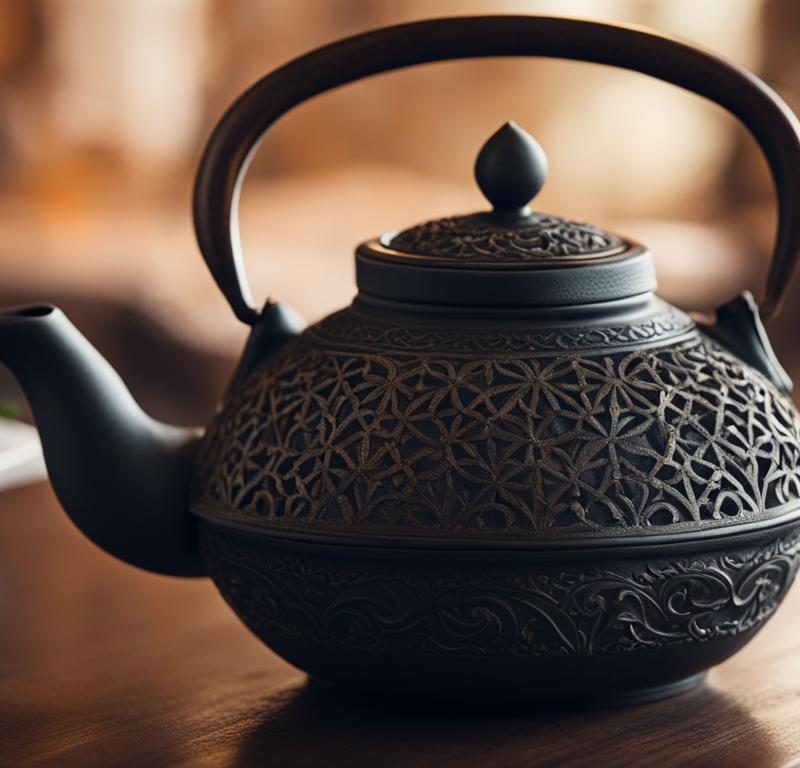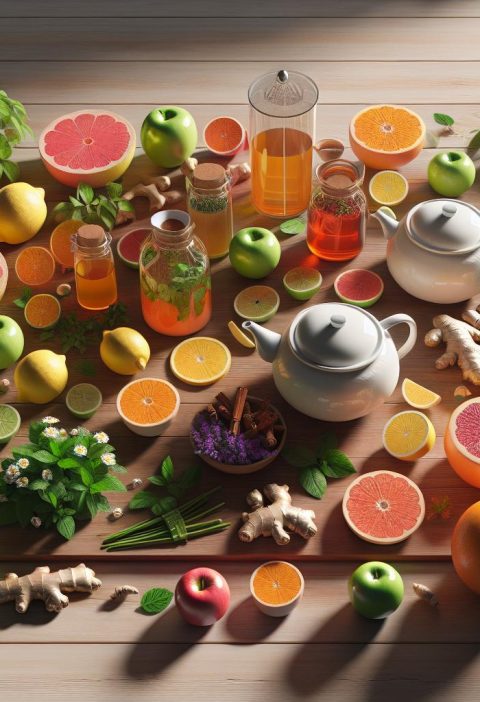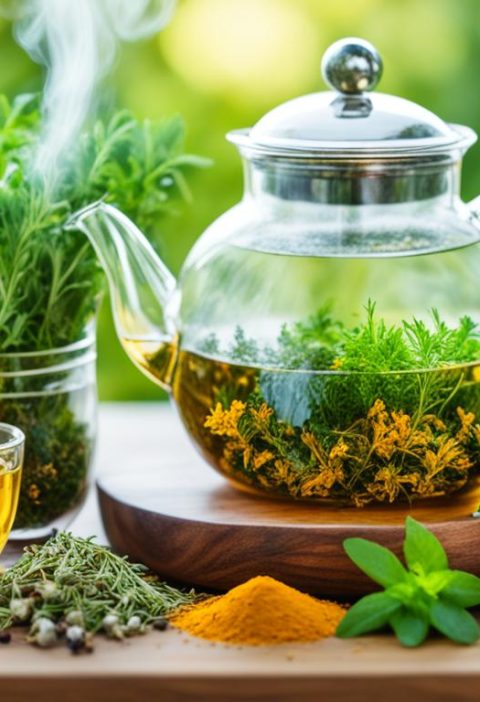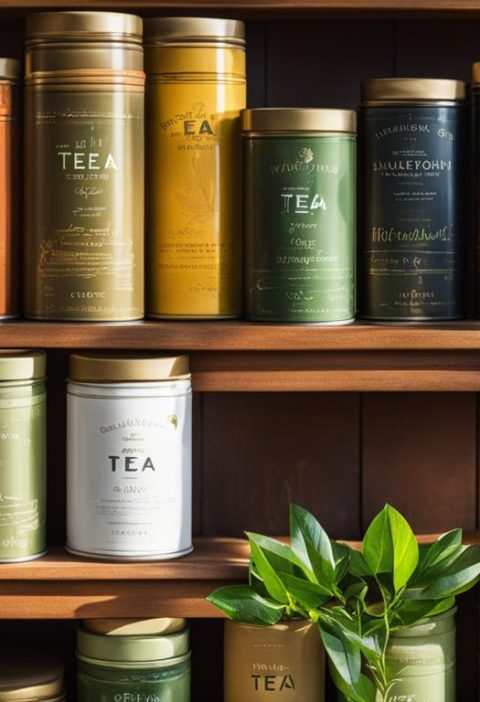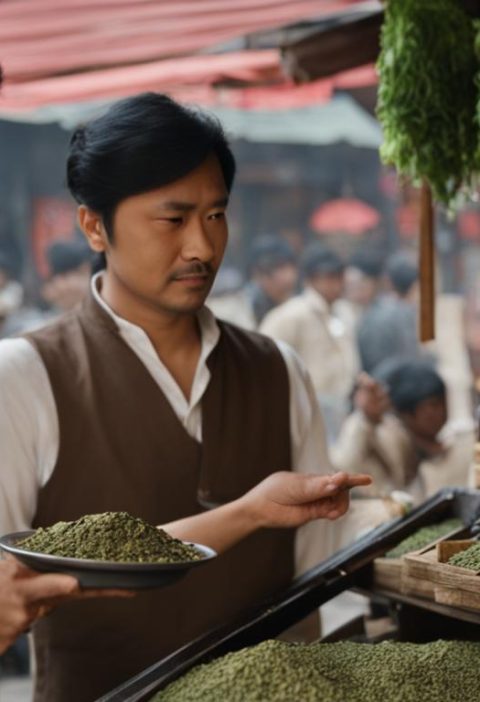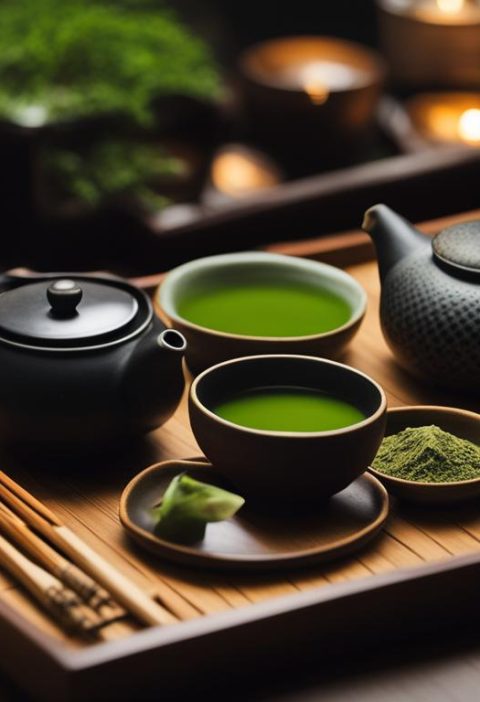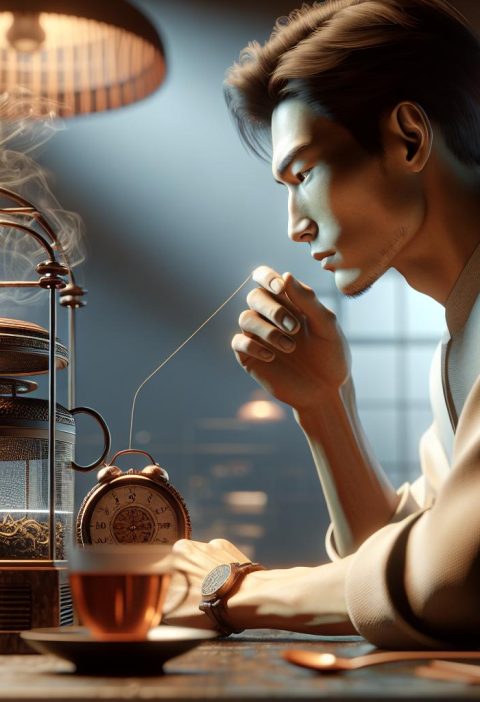Are you a tea lover looking to enhance your tea brewing experience? Look no further than a cast iron teapot. This versatile and durable vessel offers numerous benefits that are sure to elevate your tea ritual. With its non-toxic material, superior heat retention, and wide variety of shapes and sizes, a cast iron teapot provides the perfect brewing environment for your favorite teas. Whether you’re a tea connoisseur or simply enjoy a cup of tea to unwind, investing in a cast iron teapot is a decision you won’t regret.
Key Takeaways:
- A cast iron teapot is non-toxic and provides a safe brewing environment for your tea.
- Superior heat retention in a cast iron teapot allows for better flavor extraction from your tea leaves.
- The wide variety of shapes and sizes available in cast iron teapots ensures there’s a perfect option for every tea lover.
- The durability and long-lasting nature of cast iron teapots make them a reliable choice for tea enthusiasts.
- Using a cast iron teapot creates a therapeutic atmosphere that enhances the overall tea brewing and consumption experience.
The Design and Functionality of Cast Iron Teapots
When it comes to design and functionality, cast iron teapots truly stand out. These teapots can be crafted into various shapes and sizes, providing tea enthusiasts with a wide range of options to choose from. Unlike traditional teapot materials like clay or china, cast iron allows for more intricate patterns and vibrant colors, making it a favorite among those who appreciate artistic craftsmanship. The design possibilities are endless, ranging from floral motifs to intricate geometric patterns that add a touch of elegance to any tea setting.
However, the appeal of cast iron teapots goes beyond just aesthetics. They are built to serve multiple purposes, functioning not only as teapots but also as kettles. This versatility allows for the convenience of boiling water directly on a stove, ensuring a fresh cup of tea whenever desired. The non-conductive nature of cast iron ensures that the heat is preserved, keeping the tea hot for an extended period. This feature is especially appreciated during tea parties or when savoring tea slowly without the need for frequent reheating.
To capture the essence of cast iron teapot design and functionality, take a moment to admire this beautifully crafted teapot:
The Exquisite Craftsmanship
This cast iron teapot exemplifies the beauty and intricate craftsmanship that cast iron teapots offer. The attention to detail in the intricate design showcases the artistry behind each teapot. From the handle to the spout, every element is thoughtfully designed to create a visually stunning piece that also delivers exceptional functionality.
With its design versatility and multifunctionality, cast iron teapots are a perfect choice for both tea enthusiasts and collectors alike. Whether you prefer a traditional or contemporary design, there is a cast iron teapot that perfectly complements your style and taste. In the next section, we will explore the durability and hardwearing nature of cast iron teapots, highlighting their long-lasting value and reliability.
The Durability and Hardwearing Nature of Cast Iron Teapots
When it comes to choosing a teapot, durability is an important factor to consider. Cast iron teapots are renowned for their exceptional durability and hardwearing nature, making them a reliable choice for tea enthusiasts.
One of the key factors contributing to the longevity of cast iron teapots is the material itself. Cast iron is known for its strength and resilience, ensuring that the teapot remains in good condition even with regular use. Whether you enjoy a daily cup of tea or host tea parties, a cast iron teapot can withstand the rigors of everyday use without compromising its performance or appearance.
Another feature that enhances the durability of cast iron teapots is the enamel coating on the inside. This protective layer not only prevents rust but also adds an extra layer of robustness to the teapot. The enamel coating ensures that the teapot remains in pristine condition, allowing you to enjoy its benefits for years to come.
Furthermore, the even heat distribution of cast iron teapots contributes to their long-lasting nature. The ability to distribute heat evenly ensures that every infusion of tea is brewed to perfection, extracting the maximum flavor and aroma. This consistent heat distribution also minimizes the chances of any hotspots developing within the teapot, further preserving its durability.
Comparison: Durability of Cast Iron Teapots vs. other materials
| Material | Durability | Longevity |
|---|---|---|
| Cast Iron | ✓ | ✓ |
| Ceramic | ✓ | ✓ |
| Glass | ✗ | ✗ |
| Stainless Steel | ✓ | ✓ |
As the table shows, cast iron teapots outshine other materials in terms of durability, making them a reliable choice for tea enthusiasts who value longevity. While ceramic and stainless steel teapots also offer durability, cast iron teapots stand out due to their hardwearing nature and the enamel coating that adds an extra layer of protection.
Investing in a cast iron teapot not only ensures its durability but also adds a touch of elegance to your tea experience. The combination of timeless design and long-lasting performance makes cast iron teapots a cherished addition to any tea collection.
The Appealing Appearance of Cast Iron Teapots
Cast iron teapots are not only functional but also visually appealing. They add a touch of elegance to any tea corner or display. The unique appearance of cast iron teapots makes them a graceful ornament that enhances the overall aesthetic of a tea collection.
| Design Elements | Description |
|---|---|
| Cherry Blossoms | A delicate and beautiful symbol of the transient nature of life. |
| Dragonflies | A symbol of transformation, adaptability, and joy. |
| Elephants | A representation of strength, wisdom, and good luck. |
| Bamboo | A sign of longevity, resilience, and flexibility. |
| Koi | A symbol of good fortune, courage, and perseverance. |
| Dragons | Depicting power, strength, and auspiciousness. |
The designs of cast iron teapots have evolved to incorporate intricate patterns, various shapes, and colors. Some popular design elements include cherry blossoms, dragonflies, elephants, bamboo, koi, and dragons. These decorative cast iron teapots are not only functional but become a focal point of the tea experience, creating a visually stunning atmosphere.
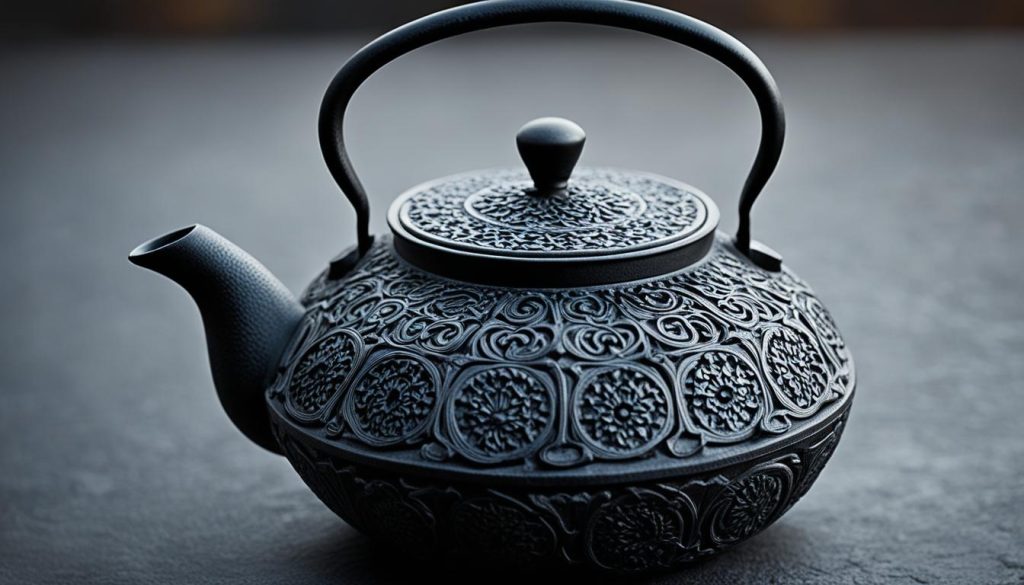
The image showcases the beautiful appearance of a cast iron teapot, further highlighting its ornamental value and unique charm.
The Therapeutic Atmosphere of Using a Cast Iron Teapot
Using a cast iron teapot creates a therapeutic atmosphere that encourages a slow and mindful tea steeping process. The pouring of the steeped tea becomes a small ceremony done with care and patience. The need to slow down and pay attention to the tea steeping process adds to the overall experience of enjoying tea. The atmosphere created by a cast iron teapot enhances the appreciation of every aspect of tea preparation and consumption.
Tea Ceremony with Cast Iron Teapot
When using a cast iron teapot, every step of the tea preparation becomes an opportunity to cultivate mindfulness. From boiling the water to pouring it over the tea leaves and savoring each sip, the tea ceremony with a cast iron teapot requires us to be fully present in the moment. The process of steeping tea becomes a meditation, allowing us to take a break from our busy lives and connect with the simple pleasure of enjoying a cup of tea.
The ritualistic nature of the tea ceremony provides a sense of calm and relaxation. The deliberate and intentional movements involved in using a cast iron teapot help us slow down and appreciate the beauty of the tea-making process. It allows us to escape the hustle and bustle of everyday life and create a peaceful atmosphere that promotes tranquility and well-being.
Mindful Tea Steeping
Mindful tea steeping is an essential aspect of using a cast iron teapot. The time and care taken to steep the tea leaves at the right temperature and for the appropriate duration result in a flavorful and aromatic cup of tea. The gentle aroma that wafts from the teapot as the tea steeps creates an anticipation and a sensory experience that delights all the senses.
The process of mindful tea steeping allows us to be fully present and engaged with the tea. It encourages us to appreciate the subtle nuances of different teas, the release of flavors as the leaves gradually unfold, and the calming aroma that fills the room. It is a moment of quiet reflection and a chance to let go of distractions and fully immerse ourselves in the experience of tea drinking.
| Benefits of Using a Cast Iron Teapot for Mindful Tea Steeping |
|---|
| Enhances the tea-drinking experience |
| Promotes relaxation and mindfulness |
| Creates a therapeutic atmosphere |
| Encourages a slower pace and appreciation of the small moments |
| Improves concentration and focus |
Differences Between Cast Iron Teapots and Japanese Tetsubin
While cast iron teapots draw inspiration from traditional Japanese tetsubin, there are some key differences between the two.
Heating Capabilities
Cast iron teapots have an enamel coating inside the pot for rust prevention, making them unsuitable for direct heating on a stove.
Tetsubin, on the other hand, are specifically designed to be heated over charcoal stoves. This method of heating affects the quality of the water and results in a mellower, sweeter cup of tea.
Variety in Design
Cast iron teapots often come in unique shapes, sizes, and colors, offering more variety to tea enthusiasts. These teapots can be found in traditional designs as well as modern patterns and vibrant colors, allowing for individual expression and style.
| Cast Iron Teapots | Tetsubin |
|---|---|
| Enamel coating for rust prevention | No enamel coating |
| Not suitable for direct heating on a stove | Designed for heating over charcoal stoves |
| Wide range of shapes, sizes, and colors | Limited options in terms of design |
These differences make cast iron teapots a versatile choice for tea brewing, while tetsubin offer a more traditional approach with a unique flavor profile.
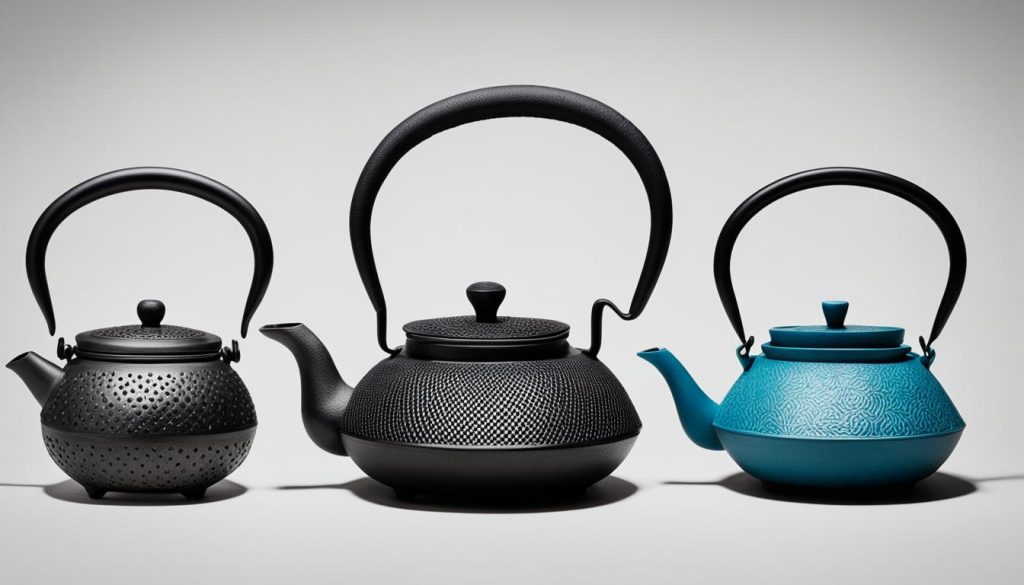
Using and Cleaning a Cast Iron Teapot
When it comes to using a cast iron teapot, a few simple steps can ensure a delightful tea experience. Before brewing your favorite tea, it is recommended to heat the pot by pouring hot water into it. This simple step helps to improve heat retention during the brewing process, resulting in a flavorful and aromatic cup of tea.
Once the pot is heated, add your desired tea leaves to the hot water. If you prefer to use tea bags or infusers, you can place them directly in the pot or use the teapot’s built-in infuser basket for easy removal. Allow the tea to steep for the recommended time, depending on the type of tea you are brewing.
After enjoying your tea, it’s essential to properly care for your cast iron teapot to maintain its longevity and performance. Cleaning a cast iron teapot is simple but requires a gentle touch. It is advised to rinse the teapot with warm water after each use, removing any remaining tea leaves. Avoid using soap or harsh cleaners, as these can damage the delicate enamel coating that protects the cast iron.
To dry the teapot, wipe it thoroughly with a clean and dry cloth. This step prevents water from lingering and potentially causing rust. Remember to air dry the teapot completely before storing it.
Proper care and maintenance will maximize the life of your cast iron teapot, ensuring many enjoyable tea moments to come.
| Using a Cast Iron Teapot: | Cleaning a Cast Iron Teapot: |
|---|---|
|
|
Cast Iron Teapots and Stove Usage
When it comes to using cast iron teapots on the stove, it’s essential to understand the appropriate usage and heating methods to ensure a delightful tea brewing experience.
Most Western cast iron teapots feature an enamel coating and exterior paint, making them unsuitable for direct heating on a stove. The enamel coating and paint can be sensitive to high temperatures, potentially causing damage to the teapot.
Traditional tetsubin, on the other hand, are made of pure cast iron without any enamel or coatings. These teapots are designed to be heated directly on a stove, allowing for the traditional Japanese tea brewing experience.
If you have a Western-style cast iron teapot, it is recommended to heat the water separately using a kettle or another appropriate method. Once the water is heated, it can then be poured into the teapot for steeping your favorite tea. This ensures that the teapot is not exposed to direct heat, preserving its enamel coating and exterior paint.
Comparing Cast Iron and Ceramic Teapots
When it comes to choosing a teapot, both cast iron and ceramic options have their own unique advantages. Let’s explore the differences between these two popular materials to help you make an informed decision.
Cast iron teapots have a distinctive aesthetic appeal that adds elegance to any tea corner or display. Their intricate patterns, shapes, and colors make them a beautiful centerpiece. Furthermore, cast iron teapots are excellent at retaining heat, keeping your tea hot for longer periods. Additionally, these teapots are known for their durability, ensuring they can withstand regular use and maintain their quality over time.
On the other hand, ceramic teapots offer a wide variety of shapes and sizes, allowing you to find a design that suits your personal preference. Cleaning ceramic teapots is generally easier compared to cast iron teapots, as ceramic surfaces are less prone to staining. However, it’s important to note that ceramic teapots can be more fragile and prone to chipping or cracking, requiring careful handling and storage.
The choice between a cast iron teapot and a ceramic teapot ultimately boils down to personal preference and the desired features for tea brewing. If you value a teapot that retains heat well and is built to last, a cast iron teapot may be the right choice for you. On the other hand, if you prefer a wider variety of designs and an easier cleaning experience, a ceramic teapot might be more suitable. Whichever you choose, both options provide a delightful way to enjoy your favorite tea blends.
